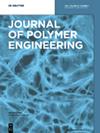织物增强环氧复合材料断裂韧性和阻尼响应的对比研究
IF 1.2
4区 材料科学
Q4 POLYMER SCIENCE
引用次数: 0
摘要
研究了织物增强环氧聚合物复合材料断裂韧性和阻尼响应的影响。按照ASTM标准制备和测试纤维含量分别为15wt%、25wt%、35wt%、45wt%和55wt %的玻璃织物、凯夫拉织物和碳织物样品。测定了织物-环氧复合材料的断裂韧性、峰值载荷和吸能增长量。观察了温度对不同百分比织物环氧复合材料的储存模量、损耗模量和tan δ值的影响,并确定了相应的阻尼响应行为。结果表明,在织物含量较高的情况下,织物强度的降低是由于织物与环氧树脂之间的粘合不当造成的。织物含量越低,峰值负荷值越高,能量吸收值越高。事实证明,凯夫拉纤维织物有利于提高比能吸收能力。碳织物环氧树脂复合材料在较高温度下的强度保持能力要好得多。织物含量较低的复合材料保持更高的温度和峰值负荷。实验结果与理论结果接近。本文章由计算机程序翻译,如有差异,请以英文原文为准。
Comparative Investigations on Fracture Toughness and Damping Response of Fabric Reinforced Epoxy Composites
Studies were conducted to observe the effect of fracture toughness and damping response on fabric reinforced epoxy polymer composites. The samples of glass fabric, kevlar fabric and carbon fabric having 15wt%, 25wt%, 35wt%, 45wt% and 55wt % fabric content were prepared and tested following ASTM standards. Fracture toughness, peak load and increase in energy absorption are determined for the fabric-epoxy composites. Effect of temperature on storage modulus, loss modulus and tan delta values for various percentages of fabric epoxy composites are noticed and corresponding damping response behaviour is determined. The results revealed that reduction in strength at higher percentage of fabric content is due to improper bonding between fabric and epoxy resin. Higher peak load values and increased values of energy absorption are observed at lower percentage of fabric content. Kevlar fabric proves to be beneficial for specific energy absorption capability. Strength retention capability at higher temperature is far better for carbon fabric epoxy combinations. Composites with lower fabric content retain much higher temperature and peak load. Also the experimental findings are in close proximity with that of theoretical results.
求助全文
通过发布文献求助,成功后即可免费获取论文全文。
去求助
来源期刊

Journal of Polymer Materials
工程技术-高分子科学
CiteScore
1.00
自引率
0.00%
发文量
27
审稿时长
4.7 months
期刊介绍:
Journal of Polymer Materials-An International Journal is published quarterly (4 issues per year), which covers broadly most of the important and fundamental areas of Polymer Science and Technology. It reports reviews on current topics and original research results on synthesis of monomers and polymers, polymer analysis, characterization and testing, properties of polymers, structure-property relation, polymer processing and fabrication, and polymer applications. Research and development activities on functional polymers, polymer blends and alloys, composites and nanocomposites, paints and surface coatings, rubbers and elastomeric materials, and adhesives are also published.
 求助内容:
求助内容: 应助结果提醒方式:
应助结果提醒方式:


